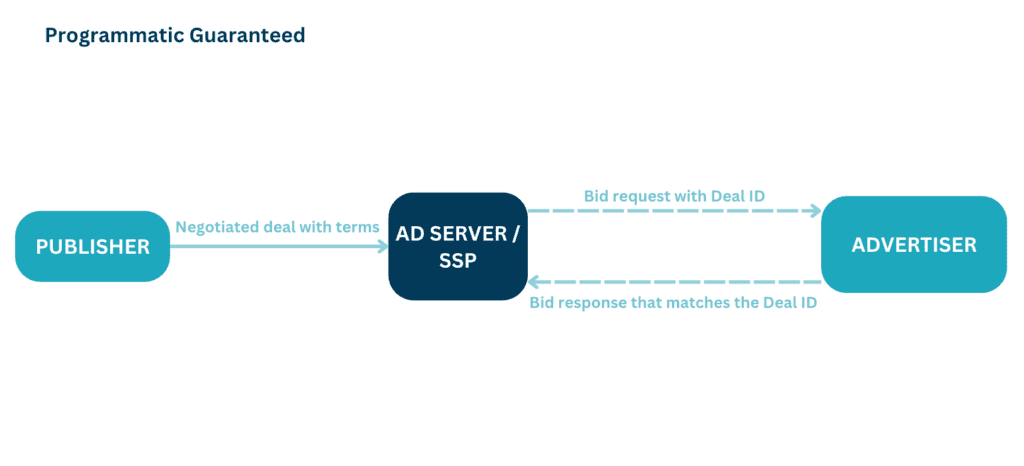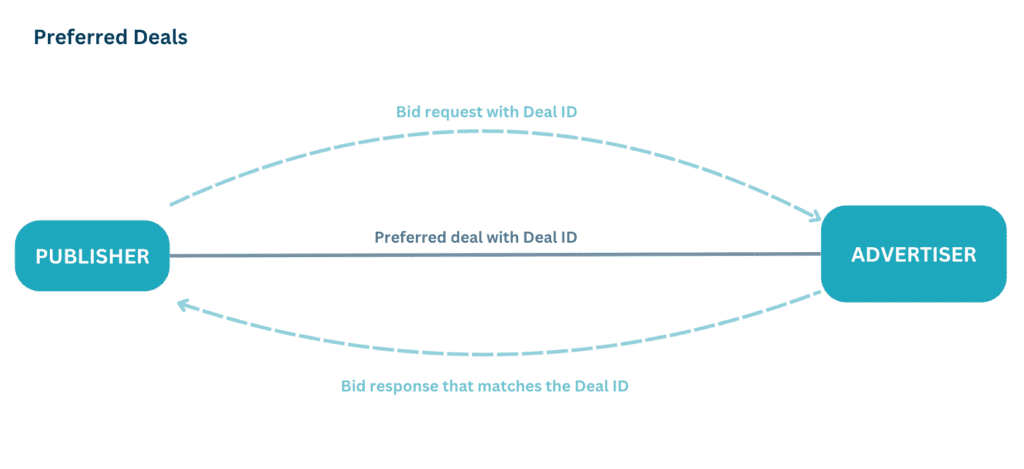What is Deal ID And Its Role in Programmatic Direct?
Deal IDs foster direct, customized connections between publishers and advertisers. These identifiers facilitate private transactions, allowing both parties to negotiate precise deal terms before any bidding begins. Their role in enhancing transparency and streamlining digital advertising makes campaigns more efficient and effective.
Curious to learn more? Keep reading!
In this article, we’ll break down what Deal ID is, its role in programmatic advertising, and its valuable benefits to publishers and advertisers!

Brief overview of programmatic advertising and its evolution
Programmatic advertising began with real-time bidding, where ads were bought and sold in open auctions as impressions became available. This approach revolutionized digital advertising by introducing automation and data integration.
As the industry matured, more sophisticated methods emerged, including private marketplaces and programmatic guaranteed deals. These offered publishers greater control over their inventory and allowed advertisers to secure premium placements through direct, negotiated deals.
Header bidding further transformed the whole process, enabling publishers to offer inventory to multiple demand sources simultaneously. Now, programmatic advertising continues to evolve, focusing on data privacy, transparency, and efficiency.
What is a Deal ID and How Does It Work?
A Deal ID (a.k.a. deal identifier) is a unique code in programmatic advertising that connects specific buyers and sellers based on pre-negotiated terms. When an advertiser wants to purchase premium ad inventory from a publisher, they negotiate details like pricing, ad formats, and audience targeting.
After reaching an agreement, the publisher’s SSP generates a Deal ID, which is shared with the advertiser. This ID ensures that the parties involved recognize and adhere to the agreed-upon conditions during real-time bidding.
- For example, suppose a publisher offers a premium ad spot at a fixed price to a select advertiser. In that case, the Deal ID facilitates this exclusive transaction, ensuring the ad appears in the desired placement under the specified terms.
SSPs, like Magnite and PubMatic, have utilized Deal IDs within their private marketplaces for a while, providing publishers with added control over which advertisers and DSPs can access and bid on their inventory.
However, the adoption of Deal IDs among video-centric media companies has been slower due to the limited availability of tailored video services for publishers (LiveRail is one of the few notable exceptions).
The Purpose and Function of Deal ID in Programmatic Direct
We’ve already noted that Deal IDs streamline the process of direct transactions in programmatic advertising. When a publisher and an advertiser agree on specific terms, the publisher’s SSP generates a Deal ID.
This unique identifier is included in bid requests, allowing DSPs to recognize and bid according to the pre-negotiated terms. This mechanism ensures that both parties adhere to the agreed-upon conditions, making these transactions more efficient and transparent.
Maintaining Control
Deal IDs grant publishers greater control over their ad inventory. By assigning Deal IDs to specific deals, publishers can dictate which advertisers can access their premium inventory and under what conditions.
This control extends to setting price floors, selecting ad formats, and defining audience segments. With this precision, publishers can protect their brand integrity and optimize revenue by ensuring that only suitable ads appear on their platforms.
Ensuring Priority Access
Publishers can also offer advertisers priority access to premium ad placements. In private marketplaces or preferred deals, publishers use Deal IDs to grant select advertisers the first opportunity to bid on high-quality inventory before it becomes available in open auctions.
This arrangement benefits advertisers by providing access to exclusive placements and publishers by securing higher bids for their premium inventory.
Key Attributes of Deal IDs
1. Ad inventory
This specifies the type and quality of ad space being offered. It could include high-visibility placements, such as above-the-fold banners or video ads, allowing advertisers to choose inventory that best suits their campaign goals.
2. Pricing details
Pricing terms define the cost of the ad placements, often set as a fixed CPM or dynamic rate. This allows publishers to set premium prices for exclusive inventory and ensures advertisers know their costs upfront.
3. Targeting criteria
Targeting allows advertisers to specify the audience segments they want to reach based on demographics, location, interests, or device type. This customization ensures ads reach the intended audience, improving campaign effectiveness.
4. Duration of the deal
This specifies how long the deal will remain active, such as a week, month, or specific campaign period. Duration settings ensure both parties know the timeline and can plan accordingly.
5. Volume commitment
Volume commitment refers to the agreed-upon number of impressions, or ad views the advertiser commits to purchasing within the deal’s timeframe. It gives publishers predictable revenue and advertisers guaranteed reach.
6. Technology platforms
Technology platforms indicate the DSPs, SSPs, and other tech providers executing the deal. This ensures compatibility between the parties’ systems for smoother transactions.
7. Data sharing agreements
This covers the terms of data exchange between the publisher and advertiser, detailing what data will be shared and how it will be used. It helps both sides make informed decisions while ensuring compliance with privacy laws.
8. Deal prioritization
Deal prioritization assigns a priority level to specific deals, ensuring they are served ahead of other programmatic ads. Higher-priority deals receive placement preference, allowing advertisers to secure top positions in desired inventory.
9. Daytime parting
Also known as dayparting, this option allows advertisers to set specific times of day or days of the week for ad delivery.
- For example, a food delivery ad might run during lunch, maximizing relevance and effectiveness.
Benefits of Deal ID in Programmatic Direct
Transparency and control
With Deal ID, publishers and advertisers know exactly who they work with. This direct connection builds trust, as both sides can see the terms and participants involved in each deal.
Private marketplaces already grant publishers more control over their ad inventory by limiting access to select advertisers and DSPs. Deal IDs add an extra layer of specificity by creating a unique identifier that explicitly defines the terms of a deal between an SSP and a DSP.
Efficiency
Deal IDs save publishers from the headache of having to use tags. A single deal ID contains a whole list of criteria that would otherwise require individual tags. Plus, unlike tags, using a deal ID won’t negatively impact the page load.
Publishers can also use it to offer premium inventory at higher prices since advertisers will pay more for guaranteed placements that fit their campaign goals. This helps publishers increase their revenue.
Additionally, advertisers can secure high-quality placements through Deal ID, such as spots on popular websites or specific ad locations usually reserved for direct deals, improving their campaign impact.
Customization and targeting
Deal ID allows advertisers and publishers to set specific terms for ad placements, such as audience type, pricing, and ad formats. This gives both parties greater control over where ads appear and ensures ads reach the right audience.
In traditional open exchanges, DSPs often have a wide-open flow of bids, making it challenging for sellers (publishers) and buyers (advertisers) to negotiate or enforce specific deal terms during RTB.
Deal IDs allow publishers to apply specific rules to the ads purchased by DSPs, ensuring that transactions adhere to predefined conditions and giving publishers more influence over how their inventory is sold and utilized.
Example of Deal ID
A Deal ID is a unique alphanumeric string generated by the publisher’s ad server or SSP.
It can vary in format but often looks like a sequence of numbers, letters, or both. This ID is used during bid requests and responses to ensure both parties adhere to the agreed-upon deal terms.
- For example,
162548265268orAB12345XYZ789
The format and structure may differ depending on the platform that generates it. Still, it serves as a unique reference to identify a specific programmatic deal between a buyer and a seller.
How are Deal IDs Used in Different Types of Programmatic Deals?
Private Marketplaces (PMP)
In private auctions, publishers offer premium ad inventory to a select group of advertisers through a private marketplace. After agreeing on terms, the publisher sends a Deal ID along with the bid request.
DSPs match this ID with their pre-established deal terms, allowing only those with the correct Deal ID to bid.
However, if an advertiser chooses not to participate in the private auction and competes for impressions in an open auction instead, their demand partner may set the Deal ID to “1” in the bid response to indicate non-participation.

Programmatic Guaranteed
In programmatic guaranteed deals, Deal IDs facilitate direct, pre-negotiated transactions between a publisher and an advertiser, ensuring that the deal terms are precisely met.
The publisher and advertiser agree on specific terms, and once they are finalized, a unique Deal ID represents this agreement. It serves as a reference point that connects the advertiser’s DSP with the publisher’s ad server, ensuring that all transactions related to the deal adhere to the agreed-upon terms.
When the publisher’s ad server requests ad impressions covered under the programmatic guaranteed deal, it includes the unique Deal ID. The advertiser’s DSP responds with a bid that matches the previously agreed conditions.
The ad is delivered according to the terms if the bid meets all requirements. If the bid does not match, it is rejected.

Preferred Deals
Preferred deals involve a one-to-one agreement between a publisher and a single advertiser at a fixed CPM. The publisher shares the Deal ID with the advertiser, who then uses it in bid responses.
- For example, if the deal sets CPM at $3.00 with Deal_ID = 123, the advertiser can participate by responding with the same Deal ID and CPM rate. If they bid below $3.00 or skip the Deal ID, the bid won’t be considered, ensuring only those matching the fixed terms participate.

Challenges and Considerations for Using Deal ID
Technical Complexities
Implementing Deal IDs can be technically challenging. Setting up and managing them requires precise coordination between publishers and advertisers. Both parties must ensure their systems, such as SSPs and DSPs, are compatible and correctly configured to recognize and process Deal IDs.
Misconfigurations or compatibility issues can lead to failed transactions or misaligned ad placements, disrupting campaigns and potentially causing revenue loss.
Transparency vs. Control
Deal IDs offer transparency by clearly defining the terms of a deal, including pricing, targeting, and inventory specifics. However, this transparency can sometimes conflict with the level of control each party desires.
Advertisers may seek more flexibility to adjust campaign parameters on the fly, while publishers might want to maintain strict control over their premium inventory. Balancing these needs requires clear communication and well-defined agreements to ensure both parties feel confident in the transaction.
Measurement and Reporting
Tracking performance can be complex due to the customized nature of these deals.
Standard metrics may not fully capture the nuances of a Deal ID transaction, leading to potential discrepancies in reporting. Publishers and advertisers must establish clear measurement criteria and utilize robust analytics tools to monitor performance effectively.
Thus, regular communication helps promptly address reporting issues.

Conclusion
In a nutshell, Deal IDs enable direct transactions, improve control over ad placements, and guarantee priority access to premium inventory. Their role in enhancing transparency and streamlining digital advertising makes campaigns more efficient and effective, fostering trust between all parties involved.
Deal IDs offer a tailored, structured approach that benefits both publishers and advertisers. They empower publishers to control their premium inventory, negotiate preferential deals, and go beyond simple pricing considerations by cultivating precise terms and conditions within private marketplaces.
While Deal IDs offer significant advantages, such as reduced ad fraud risk and more efficient deals, they also require careful configuration to avoid issues like failed matches or missed revenue. As programmatic advertising evolves, Deal IDs are expected to drive more budgets toward private deals, strengthening the connection between buyers and sellers and creating a more transparent and effective market.


